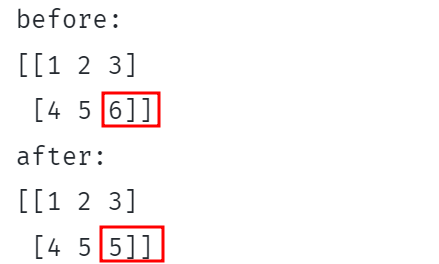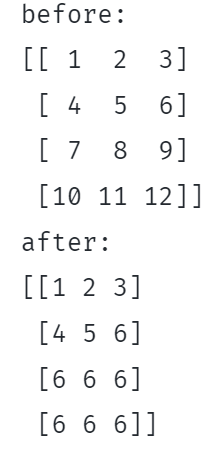NumPy np.clip()
The clip() function in NumPy allows you to limit the values passed to it by specifying the min and max range values.
Function Syntax
The function syntax is as shown below:
Parameter Values
The function accepts the following parameters:
- a – refers to the input array.
- a_min – the minimum value that can be inserted in the array.
- a_max – the maximum value accepted by the array.
- out – specifies an output array to store the result.
Return Value
The function will return an array with the specified elements of the input array. Any values less than a_min are replaced with a_min, while values greater than a_max are replaced with a max.
For example, if a_min = 1 and a_max = 1, values less than one are replaced with one and values greater than ten are replaced with 10.
Example #1
Consider the example shown below:
import numpy as np
arr = np.array([[1,2,3], [4,5,6]])
print(f"before:\n{arr}")
arr_clip = np.clip(arr, a_min=1, a_max=5)
print(f"after:\n{arr_clip}")
In this example, we have an array with values ranging from 1 to 6. We then use the clip function and set the min value to 1 and the max value to 5.
Since six is greater than the max value, the function will replace it with five and return the array as shown:

Example #2
You can also pass an array to the a_min or a_max parameters. Consider the example below:
print(f"before:\n{arr}")
arr_clip = np.clip(arr, a_min=[1,2,3], a_max=6)
print(f"after:\n{arr_clip}")
The code above should return:

Conclusion
In this article, we discussed the clip function in NumPy and how to use it to limit the minimum and maximum values an array can accept.
Thanks for reading!!
Source: linuxhint.com
